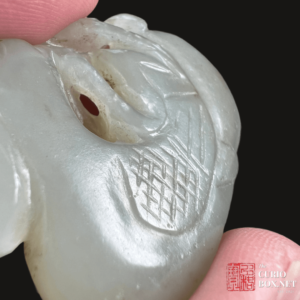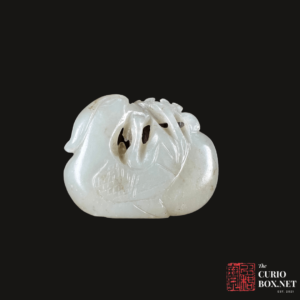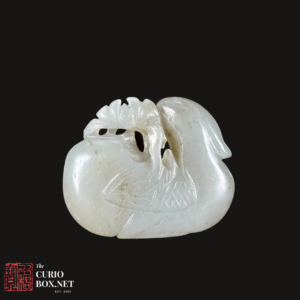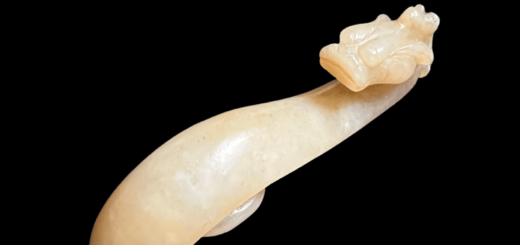【多寶格】鵝持靈芝 – 傳統中華文化中的吉祥象徵 Goose with Lingzhi – A Symbol of Auspiciousness in Traditional Chinese Culture
在傳統中華文化中,我們經常能遇見各式各樣的吉祥象徵,這些象徵通常以手工藝品的形式呈現。其中,常見的一個形象是鵝持靈芝。實際上,鵝與靈芝之間或許並無直接聯繫,鵝也並不以靈芝為食,但在民間藝術的領域裡,這一組合蘊含了深厚的象徵意義。
首先,讓我們探討靈芝的象徵意義。在傳統中華文化中,民間藝術經常強調「有意味的物件」,這些物件體現了吉祥和正面的含義。靈芝是一種珍貴的藥用菌,亦稱為「如意」。在這裡,「如意」並非指某物,而是象徵著一切隨心所願,就如同實現一個美好的願望,無論是中大獎或是事業順利發展——都由一個人的願望所主宰。
鵝的象徵意義
接著,讓我們深入了解鵝的象徵意義。在傳統中華文化中,同音字經常被用來產生不同的含義。在這個語境下,鵝具有特殊的意義,因為它的發音與中文「我」字相似。這種巧妙運用同音字的做法,是民間藝術中常見的實踐,豐富了物件的含義,並賦予它們一種詼諧感。
因此,鵝持靈芝的象徵意義變得引人入勝。靈芝代表著正面願望的實現,而鵝象徵著自我。當這兩者結合時,便形成了「我願成真」的意義。這樣的吉祥物,不僅攜帶著繁榮和好運的祝福,也承載著獨特的文化精髓。
表達吉祥的願望
以「我願成真」為主題的圓雕玉墜,展現了典型的明清風格。精湛的工藝揭示了使用古老工具手工打磨的痕跡,增強了玉石中古老魅力的體現。這件藝術品,滿載著吉祥的意義,不僅具有巨大的藝術價值,也是值得保存的寶貴文化遺產。
在傳統中華文化中,我們經常利用有意義的物件來表達吉祥的願望,而鵝持靈芝便是這一方面的卓越代表。這些藝術作品讓我們不僅能夠賞析其美學,還能體會到傳統文化的智慧與獨特性。無論是在藝術欣賞的交流中,還是作為收藏品的投資,這些文物確實是珍貴的寶藏。讓我們一同珍惜這份寶貴,通過時光的流逝,永遠保持傳統中華文化的光輝。






In traditional Chinese culture, we often come across various auspicious symbols in the form of crafted artworks. One common representation that frequently appears is that of a goose holding Lingzhi mushrooms. While in reality, there might not be a direct connection between geese and Lingzhi mushrooms, and geese are not known for consuming Lingzhi, in the realm of folk art, this combination holds profound symbolic meaning.
Firstly, let’s explore the symbolism of Lingzhi. In traditional Chinese culture, folk artworks often emphasize the concept of “meaningful objects,” which embody auspicious and positive connotations. Lingzhi is a precious type of medicinal mushroom, also known as “Ruyi.” In this context, “Ruyi” doesn’t refer to an object but rather signifies that everything will happen according to one’s wishes, just like fulfilling a beautiful desire, whether it be winning a grand prize or smoothly progressing in one’s career – all governed by one’s aspirations.
Next, let’s delve into the symbolism of the goose. In traditional Chinese culture, homophones are frequently employed to generate different meanings. The goose, in this context, holds special significance as its pronunciation is similar to the Chinese word for “me” or “my.” This clever use of homophones is a common practice in folk art, enriching the meaning of objects and infusing them with a sense of whimsy.
Thus, the symbolism behind the goose with Lingzhi becomes intriguing. Lingzhi represents the fulfillment of positive wishes, while the goose symbolizes oneself. When combined, they form the meaning of “my wishes come true.” Such an auspicious object not only carries blessings of prosperity and good fortune but also carries a distinctive cultural essence.
The circular-carved jade pendant with the theme of “my wishes come true” exhibits a typical Ming and Qing dynasty style. The meticulous craftsmanship reveals traces of hand-polishing with old tools, enhancing the charm of antiquity in the jade. This art piece, laden with auspicious meanings, possesses not only great artistic value but also qualifies as a valuable cultural heritage worthy of preservation.
In traditional Chinese culture, we often use meaningful objects to express auspicious wishes, and the goose with Lingzhi is a remarkable representation in this regard. Such artworks allow us to appreciate not only the aesthetics but also the wisdom and uniqueness of traditional culture. Whether in the exchange of artistic appreciation or as a collectible investment, these artifacts are indeed precious treasures. Let us cherish this gem together and keep the radiance of traditional Chinese culture forever vibrant through the passage of time.



